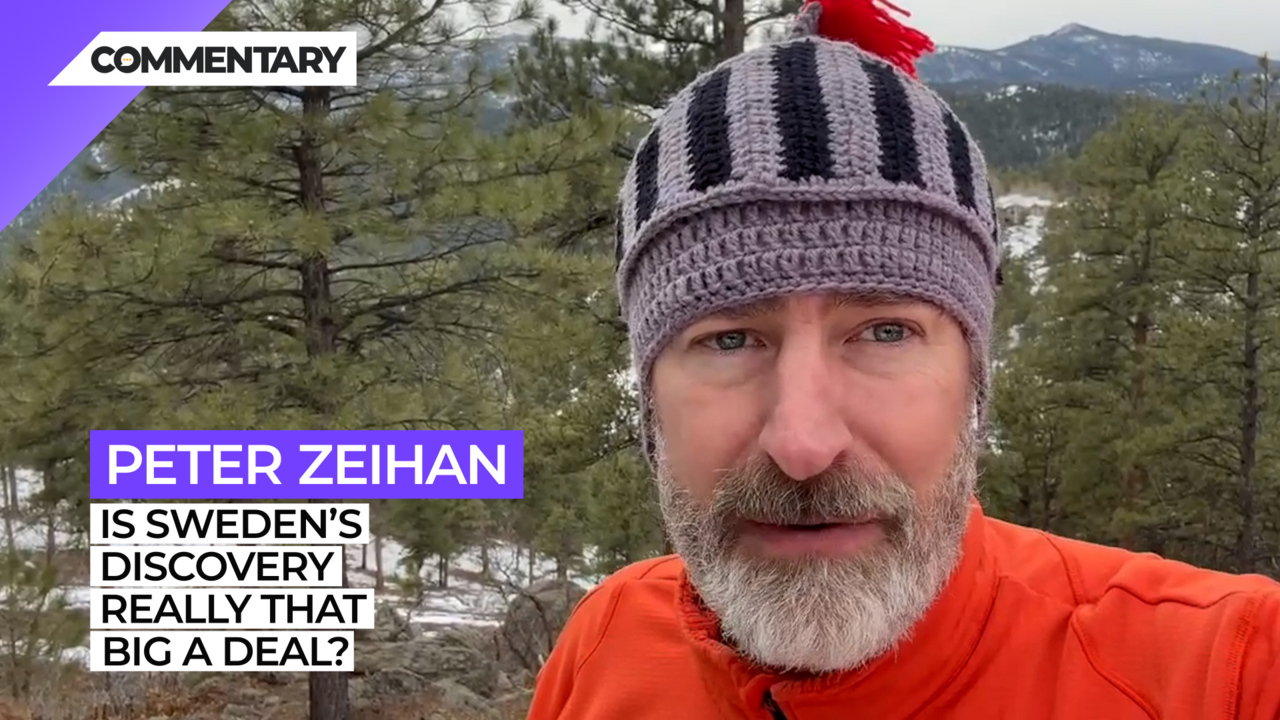
Commentary
-
Our commentary partners will help you reach your own conclusions on complex topics.
Hello from cloudy and soon to be snowing, Colorado. The big news of late is that in Sweden, a state-owned mining company, has announced that it’s found a million metric tons of rare earth oxides. And a lot of folks are saying, you know, this is what’s going to break China’s stranglehold on that space.
Rare earth metals are used in a lot of different technological applications. A little goes a long way. They’re used in everything from sunglasses to photo development to green tech to semiconductors. So kind of a big space, and the Chinese do dominate at the moment about 90% of total supply. But I’m really not all excited about this Swedish announcement for three big reasons.
Number one, this is Europe, and you don’t have to find a lot in the ground for it to be Europe’s largest deposit of anything. So a million tonnes of oxides sounds like a lot. But generally out of every tonne or two of rock, you only get about an ounce of material. So while a little does go a long way, this really isn’t all that much.
Second, this is still Europe, and the Swedes themselves are saying 10 to 15 years before the first stuff makes it to market. The technologies involved in purifying rare earth requires several 100 vats of acid as you slowly dissolve and then tease out the materials from one another. They all have similar physical characteristics and atomic weights. So separating them is very difficult, and honestly a little toxic.
Third, but most importantly, it really doesn’t matter because we really don’t have a rare earths problem. And yes, yes, yes, 90% do come from the Chinese. But there’s a few things about rare earths that most people just have forgotten.
-
Is the US looking for a war?
With conflicts, skirmishes and tensions simmering around the globe, and with the United States playing supporting roles in several of them, the question of whether the country getting involved directly is legitimate. The war in Ukraine, for example, has forced several European countries to reintroduce mandatory military service to confront the growing threat from Moscow.…
-
How future generations could shift US support for Israel
Israeli Prime Minister Benjamin Netanyahu addressed a joint meeting of Congress on July 24, calling for increased bipartisan support for Israel amid its 10-month war with Hamas. He praised President Biden’s “half century of friendship to Israel” and referred to Hamas as “sheer evil.” In the video above, Straight Arrow News contributor Peter Zeihan analyzes…
-
Why election of European Commission president is so important
Ursula von der Leyen has been reelected to another five-year term as president of the European Commission after a vote by EU lawmakers. Von der Leyen will now preside over a coalition that shifted to the right after recent European elections, where ultra-conservative parties won a record number of seats. In July, von der Leyen…
-
Protests in Bangladesh signal more trouble ahead
Public protests in Bangladesh against government hiring practices — and against the government’s military response to those protests — have left at least 174 dead and 2,500 jailed. Bangladesh’s people face an acute jobs and unemployment crisis, so public disagreements over hiring practices carry significant weight. The regime recently enforced a nationwide internet blackout as…
-
In US election, early polling doesn’t tell us anything yet
From President Joe Biden’s declining health to the attempted assassination of Donald Trump, there’s been a series of major political developments in the United States that might impact the results of the November election. These developments have led to renewed confusion, concern and debate regarding which candidate might win, and in the Democrats’ case, which…
Latest Stories
-
 U.S. Department of Defense
U.S. Department of Defense
Congress still trying to figure out how to reduce wasteful military spending
-
 DVIDS
DVIDS
US Navy, Air Force making waves with new weapons at RIMPAC
-
 Getty Images
Getty Images
Israeli PM Netanyahu meets with Trump at Mar-a-Lago
-
 Getty Images
Getty Images
Growing US nuclear power resurgence reaches the nation’s heartland
-
 Getty Images
Getty Images
Beer from the sun, other solar thermal projects get government funding
Popular Opinions
-
In addition to the facts, we believe it’s vital to hear perspectives from all sides of the political spectrum.
Latest Opinions
In addition to the facts, we believe it’s vital to hear perspectives from all sides of the political spectrum. We hope these different voices will help you reach your own conclusions.
The opinions published in this section are solely those of the contributors and do not reflect the views of Straight Arrow News.

















Latest Commentary
We know it is important to hear from a diverse range of observers on the complex topics we face and believe our commentary partners will help you reach your own conclusions.
The commentaries published in this section are solely those of the contributors and do not reflect the views of Straight Arrow News.
Peter Zeihan
Geopolitical StrategistHow future generations could shift US support for Israel
Why election of European Commission president is so important
Protests in Bangladesh signal more trouble ahead
Dr. Frank Luntz
Pollster and Political Analyst‘I don’t know’: Swing voters debate who best to replace Biden
‘Mad as hell’: Americans vent anger, frustration over politics
‘On death’s door’: Undecided voters react to first debate